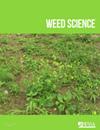评估三种甘薯(Ipomoea batatas)栽培品种的关键无杂草期
IF 2.1
2区 农林科学
Q2 AGRONOMY
引用次数: 0
摘要
甘薯(Ipomoea batatas (L.) Lam.产量损失会因栽培品种、生产环境、杂草种类和管理技术的不同而有很大差异。为了应对这一挑战,我们于 2022 年在印第安纳州拉斐特的塞缪尔-G-梅格斯园艺研究农场和印第安纳州文森的普渡西南农业中心进行了实地研究,以确定甘薯栽培品种对关键无杂草期的影响。试验采用分小区设计,无杂草间隔期处理为主小区因子,栽培品种为副小区因子。使用的三个栽培品种是 Covington、Monaco 和 Murasaki。从移栽后 0、14、21、28、35 或 42 天(DAP)开始,人工清除杂草,让杂草生长并与作物竞争。随着无杂草间隔期从 0 天到 42 天的增加,在拉法叶特地区,科文顿的预测总产量从每公顷 19 千克增加到每公顷 20,540 千克,摩纳哥的预测总产量从每公顷 3 千克增加到每公顷 11,407 千克,村崎的预测总产量从每公顷 125 千克增加到每公顷 13,460 千克。在文森斯,随着无杂草间隔期从 0 DAP 增加到 42 DAP,预测总产量从科文顿的 14,664 千克/公顷增加到 33,905 千克/公顷,摩纳哥的 4,817 千克/公顷增加到 18,059 千克/公顷,村崎的 12,735 千克/公顷增加到 21,105 千克/公顷。科文顿、村崎和摩纳哥的甘薯在 24 DAP、20 DAP 和 33 DAP 期间保持无杂草,总减产阈值≤10%。本文章由计算机程序翻译,如有差异,请以英文原文为准。
Evaluation of critical weed-free period for three sweetpotato (Ipomoea batatas) cultivars
Sweetpotato [Ipomoea batatas (L.) Lam.] is a staple crop that provides nutritional benefits to humans globally, but it is subjected to yield loss when competing with weeds, especially during the early stage of establishment. Yield loss can vary widely based on the cultivar, production environment, weed species, and management techniques. To address this challenge, we conducted field research at the Samuel G. Meigs Horticulture Research Farm, Lafayette, IN, and at the Southwest Purdue Agricultural Center, Vincennes, IN, in 2022 to determine the effect of sweetpotato cultivar on the critical weed-free period. The experiment was a split-plot design, with weed-free interval treatments as the main plot factor and cultivar as the subplot factor. The three cultivars used were Covington, Monaco, and Murasaki. Weeds were removed by hand and allowed to establish and compete with the crop beginning at 0, 14, 21, 28, 35, or 42 days after transplanting (DAP). As weed-free interval increased from 0 to 42 DAP, predicted total yield increased from 19 kg ha-1 to 20,540 kg ha-1 for Covington, 3 kg ha-1 to 11,407 kg ha-1 for Monaco, and 125 kg ha-1 to 13,460 kg ha-1 for Murasaki at the Lafayette location. At Vincennes, as weed-free interval increased from 0 to 42 DAP, predicted total yield increased from 14,664 kg ha-1 to 33,905 kg ha-1 for Covington, 4,817 kg ha-1 to 18,059 kg ha-1 for Monaco, and 12,735 kg ha-1 to 21,105 kg ha-1 for Murasaki. A threshold of ≤10% total yield reduction was achieved by maintaining sweetpotatoes weed-free 24 DAP for Covington, 20 DAP for Murasaki, and 33 DAP for Monaco.
求助全文
通过发布文献求助,成功后即可免费获取论文全文。
去求助
来源期刊

Weed Science
农林科学-农艺学
CiteScore
4.60
自引率
12.00%
发文量
64
审稿时长
12-24 weeks
期刊介绍:
Weed Science publishes original research and scholarship in the form of peer-reviewed articles focused on fundamental research directly related to all aspects of weed science in agricultural systems. Topics for Weed Science include:
- the biology and ecology of weeds in agricultural, forestry, aquatic, turf, recreational, rights-of-way and other settings, genetics of weeds
- herbicide resistance, chemistry, biochemistry, physiology and molecular action of herbicides and plant growth regulators used to manage undesirable vegetation
- ecology of cropping and other agricultural systems as they relate to weed management
- biological and ecological aspects of weed control tools including biological agents, and herbicide resistant crops
- effect of weed management on soil, air and water.
 求助内容:
求助内容: 应助结果提醒方式:
应助结果提醒方式:


